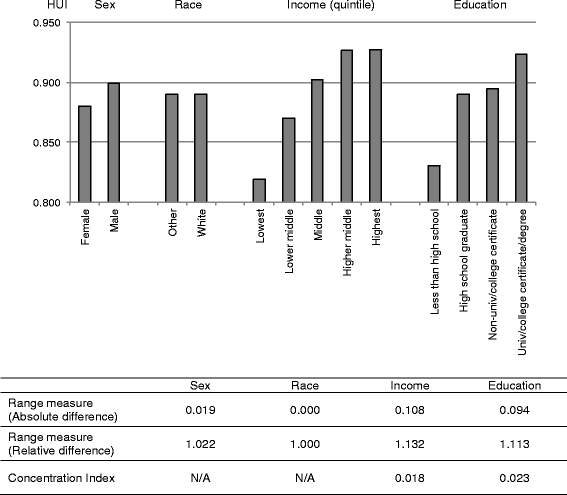A three-stage approach to measuring health inequalities and inequities
- PMID: 25366343
- PMCID: PMC4222403
- DOI: 10.1186/s12939-014-0098-y
A three-stage approach to measuring health inequalities and inequities
Abstract
Introduction: Measurement of health inequities is fundamental to all health equity initiatives. It is complex because it requires considerations of ethics, methods, and policy. Drawing upon the recent developments in related specialized fields, in this paper we incorporate alternative definitions of health inequity explicitly and transparently in its measurement. We propose a three-stage approach to measuring health inequities that assembles univariate health inequality, univariate health inequity, and bivariate health inequities in a systematic and comparative manner.
Methods: We illustrate the application of the three-stage approach using the Joint Canada/United States Survey of Health, measuring health by the Health Utilities Index (HUI). Univariate health inequality is the distribution of the observed HUI across individuals. Univariate health inequity is the distribution of unfair HUI--components of HUI associated with ethically unacceptable factors--across individuals. To estimate the unfair HUI, we apply two popular definitions of inequity: "equal opportunity for health" (health outcomes due to factors beyond individual control are unfair), and "policy amenability" (health outcomes due to factors amenable to policy interventions are unfair). We quantify univariate health inequality and inequity using the Gini coefficient. We assess bivariate inequities using a regression-based decomposition method.
Results: Our analysis reveals that, empirically, different definitions of health inequity do not yield statistically significant differences in the estimated amount of univariate inequity. This derives from the relatively small explanatory power common in regression models describing variations in health. As is typical, our model explains about 20% of the variation in the observed HUI. With regard to bivariate inequities, income and health care show strong associations with the unfair HUI.
Conclusions: The measurement of health inequities is an excitingly multidisciplinary endeavour. Its development requires interdisciplinary integration of advances from relevant disciplines. The proposed three-stage approach is one such effort and stimulates cross-disciplinary dialogues, specifically, about conceptual and empirical significance of definitions of health inequities.
Figures
Similar articles
-
Health inequalities and inequities by age: Stability for the Health Utilities Index and divergence for the Frailty Index.SSM Popul Health. 2018 Apr 25;5:17-32. doi: 10.1016/j.ssmph.2018.04.002. eCollection 2018 Aug. SSM Popul Health. 2018. PMID: 30069499 Free PMC article.
-
Unexplained health inequality--is it unfair?Int J Equity Health. 2015 Jan 31;14:11. doi: 10.1186/s12939-015-0138-2. Int J Equity Health. 2015. PMID: 25637028 Free PMC article.
-
Utility and limitations of measures of health inequities: a theoretical perspective.Glob Health Action. 2015 Sep 9;8:27591. doi: 10.3402/gha.v8.27591. eCollection 2015. Glob Health Action. 2015. PMID: 26361347 Free PMC article.
-
Determinants of MSK health and disability--social determinants of inequities in MSK health.Best Pract Res Clin Rheumatol. 2014 Jun;28(3):411-33. doi: 10.1016/j.berh.2014.08.001. Epub 2014 Sep 8. Best Pract Res Clin Rheumatol. 2014. PMID: 25481424 Review.
-
Measuring inequalities in health: what do we know? What do we need to know?Health Policy. 2012 Jul;106(2):195-206. doi: 10.1016/j.healthpol.2012.04.007. Epub 2012 May 18. Health Policy. 2012. PMID: 22607941 Review.
Cited by
-
Driving Precision Policy Responses to Child Health and Developmental Inequities.Health Equity. 2019 Sep 26;3(1):489-494. doi: 10.1089/heq.2019.0045. eCollection 2019. Health Equity. 2019. PMID: 31559378 Free PMC article.
-
Health inequalities and inequities by age: Stability for the Health Utilities Index and divergence for the Frailty Index.SSM Popul Health. 2018 Apr 25;5:17-32. doi: 10.1016/j.ssmph.2018.04.002. eCollection 2018 Aug. SSM Popul Health. 2018. PMID: 30069499 Free PMC article.
-
Index-Based Inequality in Quality of Care: An Empirical Comparison of Apples and Pears.Clin Epidemiol. 2021 Sep 3;13:791-800. doi: 10.2147/CLEP.S311813. eCollection 2021. Clin Epidemiol. 2021. PMID: 34512032 Free PMC article.
-
Can we predict who will benefit most from biologics in severe asthma? A post-hoc analysis of two phase 3 trials.Respir Res. 2023 May 2;24(1):120. doi: 10.1186/s12931-023-02409-2. Respir Res. 2023. PMID: 37131185 Free PMC article. Clinical Trial.
-
Bridging ethics and epidemiology: Modelling ethical standards of health equity.SSM Popul Health. 2023 Aug 2;24:101481. doi: 10.1016/j.ssmph.2023.101481. eCollection 2023 Dec. SSM Popul Health. 2023. PMID: 37674979 Free PMC article.
References
Publication types
MeSH terms
Grants and funding
LinkOut - more resources
Full Text Sources
Other Literature Sources
Medical
Research Materials


